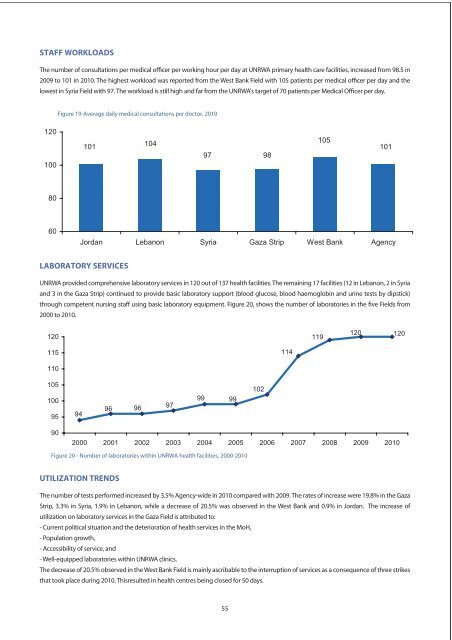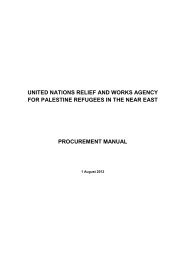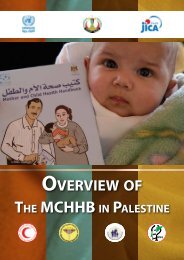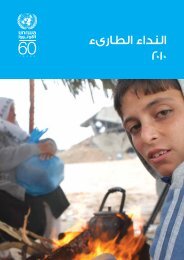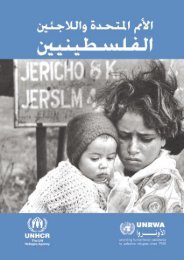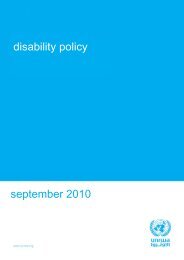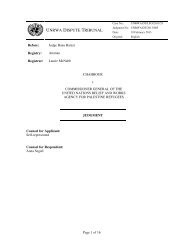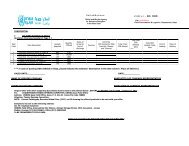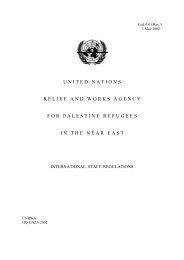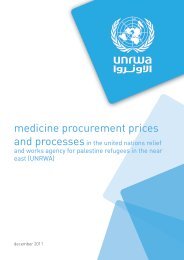Annual Report of the Department of Health 2010 - Unrwa
Annual Report of the Department of Health 2010 - Unrwa
Annual Report of the Department of Health 2010 - Unrwa
You also want an ePaper? Increase the reach of your titles
YUMPU automatically turns print PDFs into web optimized ePapers that Google loves.
STAFF WORKLOADS<br />
The number <strong>of</strong> consultations per medical <strong>of</strong>ficer per working hour per day at UNRWA primary health care facilities, increased from 98.5 in<br />
2009 to 101 in <strong>2010</strong>. The highest workload was reported from <strong>the</strong> West Bank Field with 105 patients per medical <strong>of</strong>ficer per day and <strong>the</strong><br />
lowest in Syria Field with 97. The workload is still high and far from <strong>the</strong> UNRWA's target <strong>of</strong> 70 patients per Medical Officer per day.<br />
Figure 19-Average daily medical consultations per doctor, <strong>2010</strong><br />
120<br />
100<br />
101<br />
104<br />
97 98<br />
105<br />
101<br />
80<br />
60<br />
Jordan Lebanon Syria Gaza Strip West Bank Agency<br />
LABORATORY SERVICES<br />
UNRWA provided comprehensive laboratory services in 120 out <strong>of</strong> 137 health facilities. The remaining 17 facilities (12 in Lebanon, 2 in Syria<br />
and 3 in <strong>the</strong> Gaza Strip) continued to provide basic laboratory support (blood glucose, blood haemoglobin and urine tests by dipstick)<br />
through competent nursing staff using basic laboratory equipment. Figure 20, shows <strong>the</strong> number <strong>of</strong> laboratories in <strong>the</strong> five Fields from<br />
2000 to <strong>2010</strong>.<br />
120<br />
119<br />
120<br />
120<br />
115<br />
114<br />
110<br />
105<br />
100<br />
95<br />
94<br />
96<br />
96<br />
97<br />
99 99<br />
102<br />
90<br />
2000 2001 2002 2003 2004 2005 2006 2007 2008 2009 <strong>2010</strong><br />
Figure 20 - Number <strong>of</strong> laboratories within UNRWA health facilities, 2000-<strong>2010</strong><br />
UTILIZATION TRENDS<br />
The number <strong>of</strong> tests performed increased by 3.5% Agency-wide in <strong>2010</strong> compared with 2009. The rates <strong>of</strong> increase were 19.8% in <strong>the</strong> Gaza<br />
Strip, 3.3% in Syria, 1.9% in Lebanon, while a decrease <strong>of</strong> 20.5% was observed in <strong>the</strong> West Bank and 0.9% in Jordan. The increase <strong>of</strong><br />
utilization on laboratory services in <strong>the</strong> Gaza Field is attributed to:<br />
- Current political situation and <strong>the</strong> deterioration <strong>of</strong> health services in <strong>the</strong> MoH,<br />
- Population growth,<br />
- Accessibility <strong>of</strong> service, and<br />
- Well-equipped laboratories within UNRWA clinics.<br />
The decrease <strong>of</strong> 20.5% observed in <strong>the</strong> West Bank Field is mainly ascribable to <strong>the</strong> interruption <strong>of</strong> services as a consequence <strong>of</strong> three strikes<br />
that took place during <strong>2010</strong>. Thisresulted in health centres being closed for 50 days.<br />
55


